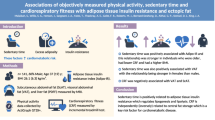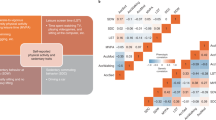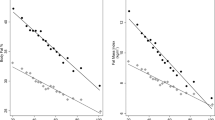Abstract
Background and Objective:
Exercise is thought to reduce high-risk body fat, but intervention studies are frequently limited by short follow-ups and observational studies by genetic selection. Therefore, we studied the effects of a physically inactive vs active lifestyle on high-risk (visceral, liver and intramuscular) fat in twin pairs discordant for leisure-time physical activity habits for over 30 years.
Design:
A longitudinal population-based twin study.
Subjects:
Sixteen middle-aged (50–74 years) same-sex twin pairs (seven monozygotic (MZ), nine dizygotic (DZ)) with long-term discordance for physical activity habits were comprehensively identified from the Finnish Twin Cohort (TWINACTIVE study). Discordance was initially defined in 1975 and the same co-twin remained significantly more active during the 32-year-long follow-up.
Main Outcome Measures:
Magnetic resonance imaging-assessed visceral, liver and intramuscular fat.
Results:
In within-pair analyses carried out after the adult life-long discordance in physical activity habits, the physically inactive co-twins had 50% greater visceral fat area compared with the active co-twins (mean difference 55.5 cm2, 95% confidence interval (CI) 7.0–104.1, P=0.010). The liver fat score was 170% higher (13.2, 95% CI 3.5–22.8, P=0.030) and the intramuscular fat area 54% higher (4.9 cm2, 95% CI 1.9–7.9, P=0.002) among the inactive co-twins. All the trends were similar for MZ and DZ pairs. Peak oxygen uptake was inversely associated with visceral (r=−0.46, P=0.012) and intramuscular fat area (r=−0.48, P=0.028), with similar trends in intrapair difference correlations (r=−0.57, P=0.021 and r=−0.50, P=0.056, respectively). The intrapair difference correlation between visceral and intramuscular fat was also high (r=0.65, P=0.009).
Conclusion:
Regular physical activity seems to be an important factor in preventing the accumulation of high-risk fat over time, even after controlling for genetic liability and childhood environment. Therefore, the prevention and treatment of obesity should emphasize the role of regular leisure-time physical activity.
This is a preview of subscription content, access via your institution
Access options
Subscribe to this journal
Receive 12 print issues and online access
$259.00 per year
only $21.58 per issue
Buy this article
- Purchase on Springer Link
- Instant access to full article PDF
Prices may be subject to local taxes which are calculated during checkout



Similar content being viewed by others
References
Wardle J, Carnell S, Haworth CM, Plomin R . Evidence for a strong genetic influence on childhood adiposity despite the force of the obesogenic environment. Am J Clin Nutr 2008; 87: 398–404.
Hill JO, Peters JC . Environmental contributions to the obesity epidemic. Science 1998; 280: 1371–1374.
Bessesen DH . Update on obesity. J Clin Endocrinol Metab 2008; 93: 2027–2034.
Despres JP . Is visceral obesity the cause of the metabolic syndrome? Ann Med 2006; 38: 52–63.
Pischon T, Boeing H, Hoffmann K, Bergmann M, Schulze MB, Overvad K et al. General and abdominal adiposity and risk of death in Europe. N Engl J Med 2008; 359: 2105–2120.
Ford ES, Mokdad AH, Giles WH . Trends in waist circumference among US adults. Obes Res 2003; 11: 1223–1231.
Okosun IS, Choi ST, Boltri JM, Parish DC, Chandra KM, Dever GE et al. Trends of abdominal adiposity in white, black, and Mexican-American adults, 1988–2000. Obes Res 2003; 11: 1010–1017.
Lilja M, Eliasson M, Stegmayr B, Olsson T, Soderberg S . Trends in obesity and its distribution: data from the northern Sweden MONICA survey, 1986–2004. Obesity (Silver Spring) 2008; 16: 1120–1128.
Despres JP, Lemieux I . Abdominal obesity and metabolic syndrome. Nature 2006; 444: 881–887.
Janiszewski PM, Ross R . Physical activity in the treatment of obesity: beyond body weight reduction. Appl Physiol Nutr Metab 2007; 32: 512–522.
Hill JO, Wyatt HR . Role of physical activity in preventing and treating obesity. J Appl Physiol 2005; 99: 765–770.
Ross R, Dagnone D, Jones PJ, Smith H, Paddags A, Hidson R et al. Reduction in obesity and related comorbid conditions after diet-induced weight loss or exercise-induced weight loss in men. A randomized, controlled trial. Ann Intern Med 2000; 133: 92–103.
Irwin ML, Yasui Y, Ulrich CM, Bowen D, Rudolph RE, Schwarts RS et al. Effect of exercise on total and intra-abdominal body fat in postmenopausal women: a randomized controlled trial. JAMA 2003; 289: 323–330.
Ross R, Janssen I, Dawson J, Kungl AM, Kuk JL, Nguyen-duy TB et al. Exercise-induced reduction in obesity and insulin resistance in women: a randomized controlled trial. Obes Res 2004; 12: 789–798.
Slentz CA, Aiken LB, Houmard JA, Bales CW, Johnson JL, Tanner CJ et al. Inactivity, exercise, and visceral fat. STRRIDE: a randomized, controlled study of exercise intensity and amount. J Appl Physiol 2005; 99: 1613–1618.
Kay SJ, Fiatarone Singh MA . The influence of physical activity on abdominal fat: a systematic review of the literature. Obes Rev 2006; 7: 183–200.
Waller K, Kaprio J, Kujala UM . Associations between long-term physical activity, waist circumference and weight gain: a 30-year longitudinal twin study. Int J Obes (Lond) 2008; 32: 353–361.
Kujala UM, Kaprio J, Koskenvuo M . Modifiable risk factors as predictors of all-cause mortality: the roles of genetics and childhood environment. Am J Epidemiol 2002; 156: 985–993.
Leskinen T, Waller K, Mutikainen S, Aaltonen S, Ronkainen PHA, Alen M et al. Effects of 32-year leisure time physical activity discordance in twin pairs on health (TWINACTIVE study); aims, design and results for physical fitness. Twin Res Human Genet 2009; 12: 108–117.
Ma H, Leskinen T, Alen M, Cheng S, Sipilä S, Heinonen A et al. Long-term leisure time physical activity and properties of bone: a twin study. J Bone Miner Res 2009; 24: 1427–1433.
Kujala UM, Kaprio J, Sarna S, Koskenvuo M . Relationship of leisure-time physical activity and mortality: the Finnish twin cohort. JAMA 1998; 279: 440–444.
Shen W, Punyanitya M, Wang Z, Gallagher D, St-Onge MP, Albu J et al. Visceral adipose tissue: relations between single-slice areas and total volume. Am J Clin Nutr 2004; 80: 271–278.
Fishbein MH, Gardner KG, Potter CJ, Schmalbrock P, Smith MA . Introduction of fast MR imaging in the assessment of hepatic steatosis. Magn Reson Imaging 1997; 15: 287–293.
Gazelle GS, Haaga JR . Hepatic neoplasms: surgically relevant segmental anatomy and imaging techniques. Am J Roentgenol 1992; 158: 1015–1018.
Chan DC, Watts GF, Ng TW, Hua J, Song S, Barrett PH . Measurement of liver fat by magnetic resonance imaging: relationships with body fat distribution, insulin sensitivity and plasma lipids in healthy men. Diabetes Obes Metab 2006; 8: 698–702.
Ruan XY, Gallagher D, Harris T, Albu J, Heymsfield S, Kuznia P et al. Estimating whole body intermuscular adipose tissue from single cross-sectional magnetic resonance images. J Appl Physiol 2007; 102: 748–754.
Goodpaster BH, Thaete FL, Kelley DE . Thigh adipose tissue distribution is associated with insulin resistance in obesity and in type 2 diabetes mellitus. Am J Clin Nutr 2000; 71: 885–892.
Marti B, Tuomilehto J, Salomaa V, Kartovaara L, Korhonen HJ, Pietinen P . Body fat distribution in the Finnish population: environmental determinants and predictive power for cardiovascular risk factor levels. J Epidemiol Community Health 1991; 45: 131–137.
Salmi JA . Body composition assessment with segmental multifrequency bioimpedance method. J Sports Sci Med 2003; 2: 1–29.
Pietrobelli A, Rubiano F, St-Onge MP, Heymsfield SB . New bioimpedance analysis system: improved phenotyping with whole-body analysis. Eur J Clin Nutr 2004; 58: 1479–1484.
Volgyi E, Tylavsky FA, Lyytikainen A, Suominen H, Alen M, Cheng S . Assessing body composition with DXA and bioimpedance: effects of obesity, physical activity, and age. Obesity (Silver Spring) 2008; 16: 700–705.
Williams RL . A note on robust variance estimation for cluster-correlated data. Biometrics 2000; 56: 645–646.
STATA. STATA Base Reference Manual. STATA Press: College Station, TX, 2005.
Catenacci VA, Wyatt HR . The role of physical activity in producing and maintaining weight loss. Nat Clin Pract Endocrinol Metab 2007; 3: 518–529.
Bouchard C, Tremblay A . Genetic influences on the response of body fat and fat distribution to positive and negative energy balances in human identical twins. J Nutr 1997; 127: 943S–947S.
Ohkawara K, Tanaka S, Miyachi M, Ishikawa-Takata K, Tabata I . A dose-response relation between aerobic exercise and visceral fat reduction: systematic review of clinical trials. Int J Obes (Lond) 2007; 31: 1786–1797.
Pietilainen KH, Rissanen A, Kaprio J, Mäkimattila S, Häkkinen AM, Westerbacka J et al. Acquired obesity is associated with increased liver fat, intra-abdominal fat, and insulin resistance in young adult monozygotic twins. Am J Physiol Endocrinol Metab 2005; 288: E768–E774.
Jakobsen MU, Berentzen T, Sorensen TI, Overvad K . Abdominal obesity and fatty liver. Epidemiol Rev 2007; 29: 77–87.
Hannukainen JC, Nuutila P, Borra R, Kaprio J, Kujala UM, Janatuinen T et al. Increased physical activity decreases hepatic free fatty acid uptake: a study in human monozygotic twins. J Physiol 2007; 578: 347–358.
Manini TM, Clark BC, Nalls MA, Goodpaster BH, Ploutz-Snyder LL, Harris TB . Reduced physical activity increases intermuscular adipose tissue in healthy young adults. Am J Clin Nutr 2007; 85: 377–384.
Boule NG, Weisnagel SJ, Lakka TA, Tremblay A, Bergman RN, Rankinen T et al. Effects of exercise training on glucose homeostasis: the HERITAGE family study. Diabetes Care 2005; 28: 108–114.
Argiles JM, Lopez-Soriano J, Almendro V, Busquets S, Lopez-Soriano FJ . Cross-talk between skeletal muscle and adipose tissue: a link with obesity? Med Res Rev 2005; 25: 49–65.
Durheim MT, Slentz CA, Bateman LA, Mabe SK, Kraus WE . Relationships between exercise-induced reductions in thigh intermuscular adipose tissue, changes in lipoprotein particle size, and visceral adiposity. Am J Physiol Endocrinol Metab 2008; 295: E407–E412.
Goodpaster BH, Chomentowski P, Ward BK, Rossi A, Glynn NW, Delmonico MJ et al. Effects of physical activity on strength and skeletal muscle fat infiltration in older adults: a randomized controlled trial. J Appl Physiol 2008; 105: 1498–1503.
Spassiani NA, Kuk JL . Exercise and the fatty liver. Appl Physiol Nutr Metab 2008; 33: 802–807.
Goodpaster BH, He J, Watkins S, Kelley DE . Skeletal muscle lipid content and insulin resistance: evidence for a paradox in endurance-trained athletes. J Clin Endocrinol Metab 2001; 86: 5755–5761.
Koster A, Leitzmann MF, Schatzkin A, Mouw T, Adams KF, van Eijk JT et al. Waist circumference and mortality. Am J Epidemiol 2008; 167: 1465–1475.
Zhang C, Rexrode KM, van Dam RM, Li TY, Hu FB . Abdominal obesity and the risk of all-cause, cardiovascular, and cancer mortality: sixteen years of follow-up in US women. Circulation 2008; 117: 1658–1667.
Hu G, Tuomilehto J, Silventoinen K, Barengo NC, Peltonen M, Jousilahti P . The effects of physical activity and body mass index on cardiovascular, cancer and all-cause mortality among 47 212 middle-aged Finnish men and women. Int J Obes (Lond) 2005; 29: 894–902.
Katzmarzyk PT, Church TS, Janssen I, Ross R, Blair SN . Metabolic syndrome, obesity, and mortality: impact of cardiorespiratory fitness. Diabetes Care 2005; 28: 391–397.
Acknowledgements
The TWINACTIVE study was supported by the Academy of Finland (Grant 114 866 and Centre of Excellence in Complex Disease Genetics) and Finnish Ministry of Education. Dr Kujala was supported by the Juho Vainio Foundation, Mrs Leskinen was supported by the Finnish Cultural Foundation, and Dr Pietiläinen was supported by Helsinki University Central Hospital Grants.
Author information
Authors and Affiliations
Corresponding author
Rights and permissions
About this article
Cite this article
Leskinen, T., Sipilä, S., Alen, M. et al. Leisure-time physical activity and high-risk fat: a longitudinal population-based twin study. Int J Obes 33, 1211–1218 (2009). https://doi.org/10.1038/ijo.2009.170
Received:
Revised:
Accepted:
Published:
Issue Date:
DOI: https://doi.org/10.1038/ijo.2009.170
Keywords
This article is cited by
-
Psychometric properties of the Portuguese version of the physical activity parenting practices questionnaire
BMC Psychology (2023)
-
Intermuscular adipose tissue in metabolic disease
Nature Reviews Endocrinology (2023)
-
Developmental trajectories of body mass index since childhood and health-related quality of life in young adulthood: Tehran Lipid and Glucose Study
Quality of Life Research (2022)
-
Relationship between physical activity time and intramuscular adipose tissue content of the thigh muscle groups of younger and older men
Scientific Reports (2021)
-
Systemic cross-talk between brain, gut, and peripheral tissues in glucose homeostasis: effects of exercise training (CROSSYS). Exercise training intervention in monozygotic twins discordant for body weight
BMC Sports Science, Medicine and Rehabilitation (2021)



